
| ||||||||
| My Artwork | ||||||||
| Awards Won |


|
This part of my site will be dedicated to discussing the Battle of Cedar Creek, in the Shenandoah Valley of Virginia and the part in which the 18th Georgia Regiment of Volunteer Infantry played in that battle. Our Great Great Grandfather,1st Lt George Right Smith had been hospitalized late July or early August 1864, in Petersburg, Va. However, on August 7th, 1864 the record shows he had rejoined the 18th Georgia Regiment of Volunteer Infantry, Company H (Rowland Highlanders), now assigned as part of Major General Joseph Kershaw's Division, as they were reassigned to operations against Union General Sheridan's Campaign in the Shenandoah Valley. |
|
On August 16,1864...they were engaged at Cedarville, and Guard Hill (Front Royal), Virginia. They next saw action at Bunker Hill, West Virginia on September 2nd and 3rd, 1864. On September 19th, 1864...they saw action in the battles of Opequan and Winchester, Virginia. Three days later, on the September 22, 1864...the 18th Georgia saw action at the battles of Fisher's Hill and Woodstock, Virginia. And lastly, on October 19, 1864, the unit saw action in the battles of Cedar Creek, Middletown, and Belle Grove, Virginia. As will be documented here, Confederate General Jubal A. Early's surprise attack at Cedar Creek is considered one of the most daring and successful uses of the combined arms of Infantry, Cavalry and Artillery and is still studied by military strategists and tacticians, today. |
 |
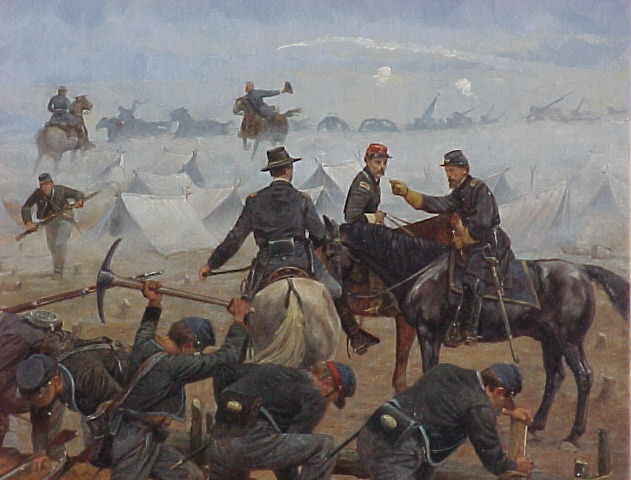 |
| Part of Union General of the Armies Ulyses S. Grants five prong offensive was to make the Shenandoah Valley uninhabitable for either Army. His plans included the destruction of the Virginia Central Railroad, a primary transport which ferried food to the beseiged Army of Northern Virginia in and around Petersburg and Richmond, or whenever possible, to destroy the food supplies themselves. In earlier operations Union Generals Franz Sigel and Hunter, had failed miserably in their campaigns in the Shenandoah Valley. However, in response to General Hunter's renewed campaign, in June of 1864, Confederate President Davis and General Robert E. Lee ordered General Jubal Early to move his II Corps to the valley and to press Union General Hunter northward, toweards the Potomac River, and if possible cross the Potomac into Maryland, threatening Washington D.C., and cause Generals Grant and Meade to weaken their stranglehold on Petersburg in order to meet the new threat of the Federal capital, Washington. However, General Hunter unpredictaly retreated to the west, rather to the north as hoped, leaving an open rote to Maryland and then on to Washington. General Early immediately took advantage of this opportunity and quickly moved his Corps northward through the Valley, defeating Union General Lew Wallace who had organized a small force at the Monocacy River. While a victory, it was also a delay of his march on Washington and it gave badly needed time for the Union VI Corps to be placed in Washington, reinforcing its defenses. This tactical move of the Union commanders prevented any serious attempt, by General Early, to make any serious moves against the Capital. He then withdrew his exhausted Corps back to the Valley. |
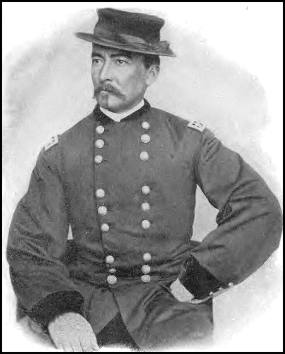
|
The command structure of the Union Army was a confused and complicated politically heated juggernaught. Because of that, no real pursuit was made to intercept or interdict General Early's withdrawing Corps. Therefore, unhenedered by Union troops, General Early took his time and chose his battles carefully. First moving against and defeating Union General George Crook's small corps at Kernstown. In so doing, his Confederates damaged railroads and looted and destroyed wagon convoys. General Grant, looking for a way to handle the out of control Confederates, appointed his trusted Cavalry commander General Philip Sheridan to command the combined forces of General Crook's VIII Corps, General Horatio Wright's VI Corps, and General William Emory's XIX Corps along with three divisions of cavalry. While General Grant's primary purpose was to destroy or control the Virginia Central Railroad, the foodbasket of the Shenandoah Valley destroyed and/or out of reach of the Confederate armies, and he also wanted this marauding Confederate corp of General Early's put out of action. General Sheridan was to take six weeks to know the capabilities of his new command and while playing a deadly tag with the Confederate force, often received different orders from Generals Grant, Halleck, and Stanton. He was to put General Early in check, defeat him of possible, but do not cause another embarrasment to the President during this time of re-election.
|
| Around mid-September, General Kershaw's division, including the 18th Georgia Regiment of Volunteer Infantry, was recalled to the defenses of Petersburg. Soon after, General Sheridan moved against Winchester. General Early's troops were unprepared, and later that day General Crooks VIII Corps made a flanking movement routing General Early's soldiers and causing him to withdraw to Fisher's Hill. On September 22, 1864...General Crook again made an end-a-round sweep and collapsed the already weakened left flank of General Early's Second Corps and drove them further up the Valley. Needing to reorganize and rest his beleagured Corps, General Early withdrew to just beyond Harrisonburg. however, General Sheridan slowly followed the Confederates and for nearly two weeks, sniped at and otherwise harrased the tired Confederate troops. While General Grant insisted on having General Sheridan hold General Early in check, while moving against the Virginia Central Railroad, General Sheridan complained that his supply lines were already over extended and difficult to protect, causing him great concern. This caused hom to fail in his primary mission and prompted General Grant to approve ogf General Sheridan's plan to withdraw from the Harrisonburg area and move back down the Valley, shortening his supply line. He ordered General Sheridan to "leave nothing for the subsistence of an army on any ground you abandon to the enemy". Obeying this command, General Sheridan's troops burned over 2000 barns filled with food stuffs, hay and farming equipment; captured 4000 head of "contraband" cattle, and over 3000 head of sheep; destroyed over 70 mills and their stockpiled wheat and flour, and brought total war to the inhabitants of the Shenandoah Valley. These times are still known as "The Burning", today.
| 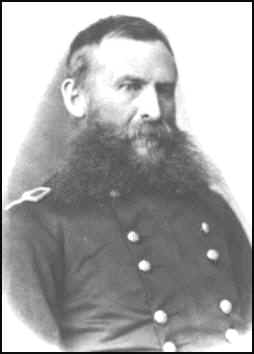 |
| Disappointed in the lackluster performance of his trusted friend, General Grant also ordered General Sheridan to return as many of his troops as possible, to the Army of the Potomac, now in a siege of Petersburg. General Sheridan, preoccupied with his new command, became careless enough that he lost track of General Early and his small force. Once, he believed the Confederates to be fifty miles away, when in fact they were very close to General Sheridan's position. |
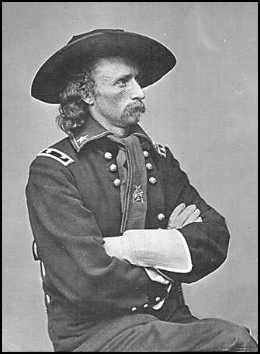
|
Finally realizing his mistake, General Sheridan ordered his cavalry to turn around and hit the Confederate cavalry commanded by General Rosser. General Rosser's horse soldiers had been successfully nipping at the Union rear guard as they moved. On or about October 9, 1864, Union cavalry Generals Merritt and Custer easily crushed the Confederate cavalry at Tom's Brook, which only served to further convince General Early that his out numbered cavalry was useless. General Jubal A. Early believed his mission was two fold, (1) hold all of the forces under General Sheridan in the Valley...unable to reinforce the Union troops at Petersburg; and (2) causing as great harm to these forces as possible, whenever presented the opportunity. As the Union troops under General Sheridan's command went into camp along Cedar Creek, he ordered the VI Corps to start moving towards Petersburg. On October 13, 1864, General Early made a reconnaissance in force that resulted in a division sized fight. General Sheridan was so alarmed that he immediately recalled the VI Corps. This helped General Early to realize one of his mission responsibilities but precluded a decisive victory the next week. An example of the gamesmenship between these two wiley opponents was when General Sheridan sent two cavalry divisions to raid the Virginia Central Railroad, General Early allowed a fake message to be intercepted...speaking of the arrival of General Longstreet's I Corps...which caused General Sheridan to cancel the raid and recall his cavalry. |
|
General Lee was growing as impatient as General Grant and wrote his Valley force commander: "I have weakened myself very much to strengthen you. It was done with the expectation of enabling you to gain such success that you could return the troops if not rejoin me yourself. I know that you have endeavored to gain that success, and believe you have done all in your power to insure it...With your united force it can be accomplished. I do not think Sheridan's infantry or cavalry numerically as large as you suppose." Like General Grant, General Lee was wrong in his long distance assessment of the situation. Geberal Sheridan was called for a conference with Secretary of War Stanton and General Halleck to discuss the possibility of completing his objective of destroying the railroad or whether or not he should return his troops to Petersburg. He left his command for this conference on October 15, 1864...with the intent to returm on October 17th, 1864. |
|
General Sheridan's army numbered approximately 30,000 troops and he had 90 pieces of artillery at Cedar Creek. The Confederate forces, while very difficult to substantiate, totaled only about 13,000 troops, with only 34 pieces of artillery. The desparity in numbers gave the Unionists a great advantage, as they outnumbered the Southerners by greater than two to one. General Sheridan placed General Crook's command to the east of the creek and south of the road running through the valley, with General Thoburn's division placed on a hill nearest the creek and General Rutherford B. Hayes' division on a separate hill behind General Thoburn. General Emory's XIX Corps, made up of two divisions, were across the road, behind earthworks on high bluffs overlooking the creek. Spreading both north and east toward Belle Grove, a large stone plantation mansion which served as General Sheridan's headquarters. To the north, across Meadow Brook, was VI Corps' three divisions. Farther to the north were where Cavalry Generals Merritt's and Custer's troops were encamped. A strong force to be dealt with, the Union troops were stacked up behind one another from south to north, over a distance of about six miles. The Federal left was anchored on Massanutten and the river, General Sheridan believed his only vulnerable spot was upstream on Cedar Creek, in the open area near Generals Custer and Merritt. As a result of pressure from his Commanding General, General Robert E. Lee, General Jubal Early began looking for an avenue of attack. General Gordon, on his own volition... accompanied by Colonels Jed Hotchkiss and Clement Evans climbed up to the signal station at the peak of Massanutten where they could see the entire Union army spread out below them. From this purch, they were able to view camps, firing positions, artillery, and pickets, and Colonel Hotchkiss carefully drew the Union positions ona map. |
|
From this map, the Confederate commanders could easily determine that General Sheridan's troops were vulnerable on the left, if the Confederate troops could attack the Federal forces there between the mountain and the river. General Gordon convinced General Early, at the next morning's command meeting, that an attack on that flank would be successful. General Gordon was tasked with finding a route to move his divisions against those of General Sheridan. He found a difficult but passable route along the base of Massanutten, which led to fords that could be used to recross the Shenandoah, and move against the left flank of the Union army. General Gordon felt that three divisions could make this movement by marching all night.
|
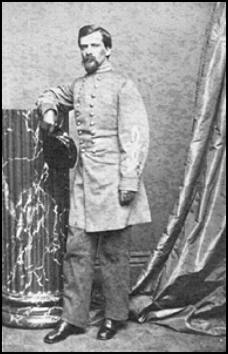
|
General Early was convinced of success and assigned General Gordon to command 5500 troops combined of troops from Generals Ramseur's, Pegram's divisions, as well as from his own division. General Pegram, who had proposed an attack on the opposite flank, returned from his own reconoiter of the Union positions and reported Union General Crook's soldiers were busy building new earthworks. General Early wisely acted on this information and adjusted the plan to have General Kershaw move through Strasburg to a ford across the creek, from which he could attack the Union position there, directly. This maneuver would in effect creating an envelopment on General Crook. Further, he instructed General Wharton to move up the pike with artillery as soon as both attacks commenced, to provide a third prong to the attack. As a diversionary, Rosser's cavalry was assigned to attack along the Back Road on the far west of the field, and to push hard enough to tie up Generals Merritt and Custer, and prevent them from coming to the support of the Union infantry. Lomax's cavalry was ordered to move about ten miles east through Front Royal to cross the river and return back to the pike attacking the rear of the Unionists. Setting the plan in motion, Hotchkiss took Ramseur's pioneers back to construct a wagon bridge over the Shenandoah for the first crossing, and to clear and mark a trail for the attacking column. On the Union side of the creek, the unsuspecting troops had enjoyed a break from the hectic pace of the past weeks, resting during the beautiful autumn weather. As a large resupply convoy arrived in their camp, with commissioners from many states to conduct their troops' voting in the Presidential election, the troops were preoccupied and gave but little thought to the war. Most were of the opinion that General Early's Confederates were too weak to go on the offensive. |
| Confederate General Gordon's column of three divisions started out from Fisher's Hill at 8:00 PM for a hard night's march, stripped of everything that may make noise. The soldiers moved carefully, in a single file, sometimes through areas that were mere trails for farm animals. The going was rough as the ground they covered was strewn with fallen logs, stones and other obstacles. By 4:00 AM, General Gordon's divisions were in position within just yards of Union cavalry videttes, who were sitting in the River. |
|
General Joseph Kershaw's Division, of which the 18th Georgia Regiment of Volunteer Infantry was a part, left at 1:00 AM for a shorter route through Strasburg, and was in sight of Thoburn's campfires at 3:30 near his ford over the creek. Everything was in the Confederate's favor...so far. Now, even the the weather was cooperating, as a dense fog formed over the entire area in the predawn coolness. General Kershaw was ordered to move his troops across the creek a few minutes ahead of schedule. Further downstream, General Gordon's combined column also moved to cross the river. One Confederate trooper would later write, "Well do I remember how we plunged into the icy waters of the Shenandoah as day was beginning to dawn, the struggle to get to the bank on the other side, and the effort to reach the top of the high embankment, now made slick by our wet clothing; how some comrade jostled me just as I reached the top and I slid back into the cold water and had to try it all over again." General Gordon's flanking force then quickly marched the mile-and-a half to the assault point. General Kershaw's supporting troops had only a short distance to cover after crossing the creek before coming to the steep hill on which the Union troops to his front were posted. The attack started there, about 5 AM. One of General Kershaw's officers would later describe the assault, "As we emerged from a thicket into the open, we could see the enemy in great commotion, but soon the works were filled with half-dressed troops, and they opened a galling fire upon us. The distance was too great in this open space to take the works by a regular advance in line of battle, so the men began to call for orders to 'charge'. Whether the order was given or not, the troops with one impulse sprang forward." | 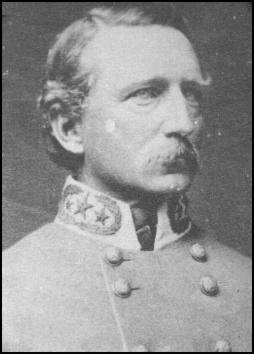 |
|
Darkness, combined with the early morning fog aided the attack. Capt. DuPont, General Crook's artillery commander, loaded his guns with canister... but could see no enemy in the dense fog, but his batteries began firing blindly toward the sounds. In the opening action, Union General Thoburn was killed, and his division was swept back in only a few minutes. Captain DuPont position was overrun and he lost an entire battery, which was quickly turned around and deftly used by the Confederates.
|
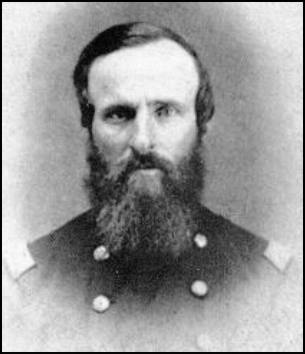
|
General Crook's second division, under General Hayes, who was positioned on a separate ridge behind that of General Thoburn, could easily tell the Confederate troops were coming and started to form his troops and facing them in that direction. However, by this time, General Gordon's troops had reached the Cooley family farmhouse, earlier established as his launching point for his part of the attack. General Gordon quickly wheeled his line of battle to the northwest, head-on into General Hayes' left flank and rear. The troops being pushed back by General Kershaw's attack, combined with the shock of General Gordon's attack, caused General Hayes' Federal division to lose cohesion and fall back across the pike toward Belle Grove. General Horatio Wright, standing in for General Sheridan in his abscence, fevorosly tried to order units of the VI Corps forward to General Hayes' support, but he was too late. It was now about 5:45 AM, early daylight. Generals Kershaw and Gordon's forces were loosely combined as they swung northwest to approach the General Emory's Union XIX Corps. General Emory said, "The fog was so dense that it was impossible to see the position of the enemy or the direction of his advance; but, guided by the firing, I ordered Second Brigade, First Division, to cross the pike and occupy a wooded ridge in order to support General Crook." An 8th Vermont company conmmander described the fight for the ridge, "The skirmish line had not advanced a hundred yards when it ran in the darkness plump into a body of the enemy; in an instant the timber was in a blaze of light from the musketry...men fought hand-to-hand...Three color bearers were killed...In a moment, without warning,...we were being swept back, every man for himself, and the enemy on every hand. I had received two severe wounds...the 8th Vermont had lost more than two-thirds of all the men engaged...of the sixteen officers at our campfire the evening before, thirteen had been killed and wounded on this horrible hill of sacrifice." |
|
However, the sacrifice of the Union troops bought time for General Horatio Wright to begin to reform his line a half-mile back (northwest), behind Belle Grove and Meadow Brook, on Red Hill. Each piece of terrain was the scene of struggle, as General Emory's XIX Corps pulled back, including a stony hill near the creek and another small knoll in front of Belle Grove. It was now about 6:45 AM, as the corps fought its way back to take position on the VI Corps' right (western) flank. Generals Kershaw and Gordon now owned the pike north of the creek. As Colonel Hotchkiss would later write in his detailed journal, "Gordon was on the left, near Stickley's; then Kershaw came across the ridge; then Ramseur down the slope to Meadow Run; Pegram from that up to the turnpike; Wharton to right with Wofford's brigade, of Kershaw's division, on his right at the angle of the Cedarville and Buckton roads; then Payne's cavalry extending to the woods. Rosser had driven the enemy by the Grove road and was to the left and in advance. We lay there some time, using some artillery on the right and left and advancing our skirmishers a little, but making no decided move. We skirmished with the cavalry on the right and they charged our lines several times, but were repulsed. Thus we lay until 4 p.m., making a few efforts to get off the immense captures we had made of artillery and everything else. We had some twenty-three guns." The Confederate success along their original lines of attack, also meant that Confederate units were becoming tangled, as they crossed one another. Time was taken to straighten and reorganize the lines. Having criss-crossed, General John Gordon's Division was on the far left, with Generals Kershaw, Ramseur, and Pegram to his right. So far, the Confederates had defeated General George Crook's two divisions separately, and then had combined Generals Kershaw and Gordon's four divisions to push Emory back. At this point, they faced the combined forces of Generals Emory and Wright's five divisions. Quoting General Early: "There was now a heavy fog, and that, combined with the smoke from the artillery and small arms, so obscured objects that the enemy's position could not be seen...Generals Ramseur and Pegram...informed me that their divisions were in line confronting the VI Corps." The VI Corps' 3rd Division, General Warren Keifer commanding, was nearest the creek, backed up by General Wheaton's 1st Division, and General Getty's 2nd Division. With the rolling terrain, dense fog, and the smoke of battle, they were effectively separated from one another and fought separate battles from 6 AM to 9 AM. One Federal soldier would later describe the situation: "The newly risen sun, huge and bloody, was on their side in more senses than one. Our line faced directly to the east, and we could see nothing but that enormous disc, rising out of the fog, while they could see every man in our line, and could take good aim." Generals Keifer and Wheaton faced east as Confederate Generals Kershaw, Ramseur and Pegram pushed beyond Belle Grove down the hill to Meadow Brook and up toward Red Hill. A Union artillerist remembered: "when the rebs came down out of the fog to the little brook to get behind the stone wall, I shouted to my comrades, 'Shoot down that flag', and we shot it down four times in less than seven minutes, and then they lay behind the wall to hold it up." The fighting, confused and complicated, continued for nearly two hours. Units fought assaults in front of them, and then on their flanks. General Wright asked one of his staff officers to ascertain whether or not the troops occupying a bluff, left of his position...were friend or foe. As the staff officer approached the strange troops, they opened fire on him causing him to barely escape with his life. With all the confusion, units were repeatedly flanked, but increasingly effective artillery fire from Union guns on the pike forced the attacking Confederates to gradually move northeast. |
|
Under orders from General Horatio Wright to move to the pike, General Getty had moved his 2nd Division into a position to the left of the others, and for a time had held a grove of trees across Meadow Brook. He moved back across the brook and into line on top of a ridge near the small cemetery just outside Middletown. In one of the key actions of the day, General Getty's troops repulsed three terrific assaults on their position, by forces led by Generals Pegram, Ramseur, and Wharton. One participant related that three times"Getty's veterans coolly held their fire until the enemy was close upon them, then delivered it in their very faces, and tumbled the shattered ranks down the hill." Losses were heavy on both sides. By now, however, Carter had nearly 20 Confederate guns positioned on the pike near Middletown, and his concentrated fire made the cemetery line untenable. About 9:30, Union General Getty began to slowly withdraw along Meadow Brook, taking a position on the pike about a mile northeast of the town. General Wright ordered the rest of VI Corps and XIX Corps to align themselves to General Getty's right. General Merritt's cavalry had come into position at this point along the pike, having been ordered by General Wright to move there with General George A. Custer. They joined Moore's cavalry brigade which had pulled back from its picket duty on the river to stake out and hold a position on the pike, making a major contribution to the Federals' attempt to stop the Confederate advance. > | 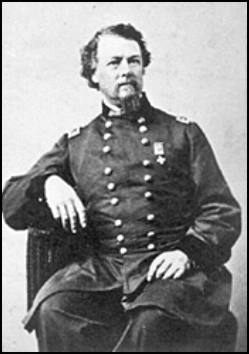 |
|
General Jubal Early wrote "The fog soon rose sufficiently for us to see the enemies position on a ridge to the west of Middletown, and it was discovered to be a strong one." He countered by moving General Pegram into position on the pike, and Generals Wharton with Wofford's Brigade (the 18th Georgia Regiment of Volunteer Infantry was one regiment in this brigade) across the pike. These forces would be in constant contact with each other through the remainder of the day. General Wofford's Brigade of Georgians had been on this part of the battlefield for some time, when General Kershaw attacked the forces under General Thoburn. In support, General Wofford had his troops move through the camps of Union Generals Hayes and Kitching, inthe wake of the assault on the Union Second Corps. Here, they fell in behind the troops of General Peagram and General Ramseur. There was a slight respit in their part of the battle and they were able to get some rest and were able to forage through the abandoned Union camps, for at least two hours. In addition, strong artillery duels occurred along the pike between Carter's guns, who fought superbly all day, and Federal guns led by DuPont, who earned a Medal of Honor for his day-long efforts. It was now about 10:30 AM. General Early entered Middletown at about this time, finding Gereals Pegram's, Wharton's and Wofford's troops actively engaged with the Union cavalry. A number of artillery batteries were deployed behind the Confederate infantry, adding what it could to assist the troops in their fight with the Union cavalry. General Early felt that the Union cavalry was threatening his right flank. |
|
At about this same moment General Philip Sheridan arrived at General Getty's position. Here he found that his stand-in, General Horatio Wright, had ordered the re-forming the Union army troops, which was well underway. General Sheridan let these orders stand, but sent General Custer back to the right flank. General Sheridan then rode the full length of his army's line, having a terrific effect on the morale of the pressed troops. General McMillan, who commanded the 1st Division, in General Emory's XIX corps, later wrote "Major General Sheridan made his appearance, and was most heartily cheered along the whole line, as far as I could observe. The officers and men seemed at once to recover from a kind of lethargy". At approximately 1:00 PM, Confederate General John Gordon directed his Confederate troops on the far left to test the Union XIX Corps position. The Confederates were quickly repulsed. As the Confederates of three divisions advanced, artillery rumbled in support. General Sheridan, who had been expecting this movement for the past two hours, shifted the Vermont brigade from their position by General Gettys and sent them to fill the threatened position, near that of Emory's reorganized corps and Wheatons's division. The Confederate thrust, which amounted to little more than a reconnaissance in force, was quickly and easily repulsed. The Union line, which was deeply set in thick woods, was practically inpenetrable. Their superior numbers, earthworks and superior position caused General Gordon to recall his troops and prevent a further needless sacrifice of his troops. Falling back to more than half the distance of their original starting position, the troops were deployed behind stonewalls and near the residence of D. J. Miller. General Early's tired Confederates' main line was now along the road leading northwest from Miller's Mill, about a half mile north of Middletown. General Sheridan planned a general counter attack for around 3:00 PM. However, he then postponed it for an hour, based on a false report of a Confederate force approaching the Union left flank from Front Royal, Va. While this could have been possible, as General Early had ordered General Lomax to make such a demonstration but he failed to do so. In fact, he and his troops never took part in the battle at all, nor did his counterpart on the other end of the line, General Thomas Rosser. This lack of support only served to bolster General Early's negative opinion of the cavalry. General Sheridan's plan for the counter attack was to cause a left wheel movement of the entire line. Sweeping the Confederates from the field as his Unon troops advanced. One of General Emory's staff officers would later recall, "The whole line will advance. The XIX Corps will move in touch with the VI Corps which will be the pivot. The right of the XIX will swing toward the left so as to drive the enemy down upon the pike."
|  |
|
However, as the Union line moved forward, it was only able to so so enmasse for about a mile, before being taken under fierce fire from the Confederates, all across the line. The fighting went back and forth, as both sides grew more and more stubborn, fiercely defending each stone fence, woods, and open fields. The battlefield was so confused, as units on both sides would surge ahead, they would quickly be flanked, forcing them to pull back before trying again. One of General Wright's VI Corps officers would later remember, "Everything appeared to be at a deadlock, with heavy firing of artillery and musketry." A Confederate officer in General Kershaw's Division wrote, "Where the Mississippi brigade stood, the fighting was at close quarters, and on the field in our front the dead and wounded lay thick." The tide began to turn against the Southerners when General Gordon's far left brigade which was facing the XIX Corps, was separated from the rest of the line. Union General McMillan's Brigade was able to wheel to the right, moving directly against the separated Confederates, driving them out of the fight. The union brigade was then wheeled back and found they were squarely on the end of the rest of General Gordon's line, flanking the Confederates. General Sheridan then ordered General Custer to coordinate his attack with the infantry. The Union brigade was reinforced and now up to division strength, they moved against the exposed Confederate flank. General Custer's cavalry, supporting the infantry, swept past that flank, later describing the fight said,"...Being compelled to advance over an open plain and in full view of the enemy, our intentions were fully and immediately comprehended by him. The effect of our movement was instantaneous and decisive. Seeing so large a force of cavalry bearing rapidly down upon an unprotected flank and their line of retreat in danger of being intercepted, the lines of the enemy now gave way in the utmost confusion." As Colonel Hotchkiss described in his journal "The enemy having had time to rally, had collected in rear of the large body of woods in our front and formed a line of battle and advanced at 4.30 p.m. obliquely to the left, and struck our left, or rather between the two brigades on the left, where the line was weak, and it gave way with little resistance, and was followed by all the rest of the line toward the left, and soon everything was in full retreat toward Cedar Creek. The artillery nobly fell back fighting and kept the enemy in check, and everything was getting off well, when Rosser, having fallen back, the Yankee cavalry crossed by Hite's old mill and came up to Stickley's and fell on our train and artillery just after dark, on Hupp's Hill, and dashed along, killing horses and turning over ambulances, caissons, &c., stampeding the drivers, thus getting 43 pieces of artillery, many wagons, &c., as there was nothing to defend them and we had no organized force to go after them." |
|
The Confederate line crumbled from left to right, as General Sheridan ordered his entire Union line to press the assault. Generals Kershaw and Ramseur fell back a quarter mile, their troops methodically retreating while giving full measure to the advancing Union troops. Near Miller's Mill, General Ramseur had two horses shot from under him and was mounting his third as he himself went down with his second wound. His troops then gave way. Across the Pike, Union cavalry General Merritt's troops had finally broken the Confederate line after several assaults, so the entire Confederate line was now in retreat. General Robert Johnston's brigade of General Pegram's Division stayed on the pike and fought a stubborn rear-guard movement. This bought valuable time for the retreating Confederates trying to get across the creek. Confederate officers tried to rally small groups of soldiers wherever they could to put up a delaying action, but their troops were now in full retreat. One Confederate veteran later remembered, "We ran. Yes, we struck the ground in high places only." |
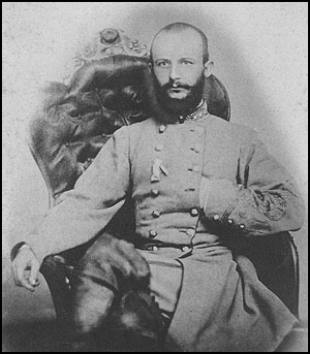
|
General Custer crossed the Creek with two regiments upstream from the bridge and as his troops cut into the confused masses on the pike, General Merritt pushed directly down the pike, taking prisoners and capturing munitions, cannons and wagons as they went. A small wagon overturned on a bridge just beyond Strasburgh, blocking it entirely. Unable to move, a large number of Confederate wagons and much needed artillery pieces were stalled helplessly and captured. General Ramseur, mortally wounded, was hidden in one of the captured wagons. Once found, his wagon was turned back to Belle Grove. Once his classmates from West Point heard of his situation, Union Generals DuPont, Merritt, and Custer, came during the night to visit him before he died. The Confederate defeat was now complete. At the plantation of Belle Grove there was a scene of Union celebration. Unit commanders presented their captures to General Sheridan, more than 300 Confederate wagons, all 24 of their own guns which had been lost in the morning plus an additional 25 Confederate guns, 1,600 rifles, and eleven captured Confederate battle flags. Confederate losses were over 2,900, including 320 killed. Union losses were over 5,600, with 644 killed. |
|
General R. E. LEE, Commanding Army of Northern Virginia. The Sixth and Nineteenth Corps have not left the Valley. I fought them both yesterday. I attacked Sheridan's camp on Cedar Creek before day yesterday morning, and surprised and routed the Eighth and Nineteenth Corps, and then drove the Sixth Corps beyond Middletown, capturing 18 pieces of artillery and 1,300 prisoners; but the enemy subsequently made a stand on the pike, and, in turn, attacked my line, and my left gave way, and the rest of the troops took a panic and could not be rallied, retreating in confusion. But for their bad conduct I should have defeated Sheridan's whole force. On the retreat back to Fisher's Hill the enemy captured about thirty pieces of artillery and some wagons and ambulances. The prisoners were brought off. My loss in men was not heavy. General Ramseur was seriously wounded while acting with gallantry, and was captured by the enemy. J. A. EARLY, Lieutenant-General.
|